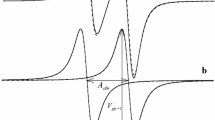Abstract
The muon level-crossing-resonance technique has been used to resolve major discrepancies that exist in muon-spin-resonance studies (both free-radical formation and muonium decay rates) in the competition between benzene and styrene. The results, obtained for ∼30 mM solutions in ethanol and for 2.5 mM aqueous micelles solutions, show that muonium atoms (Mu) react 8 (±2) times faster with styrene than with benzene. In the above cases thermalized Mu is unquestionably the reactive species, which is known to show nucleophilic intra-molecular selectivity in the case of styrene. But a similar value, 9 (±2), was also obtained for undiluted mixtures of liquid benzene and styrene (neat mixture) — where the precursor might have been ‘hot Mu’ (which should display weaker selectivity than Mu) or cations derived fromμ + (which should show higher selectivity). These results support the view that thermalized Mu is the predominant reactive species in liquid benzene and styrene.
Similar content being viewed by others
References
S. F. J. Cox, A. Hill and R. De Renzi, J. Chem. Soc. Faraday Trans.I 78 (1982) 2975.
B. W. Ng, J. M. Stadlbauer, Y. Ito, Y. Miyake, and D. C. Walker, Hyperfine Interactions17–19 (1984) 821.
P. W. F. Louwrier, G. A. Brinkman and E. Roduner, Hyperfine Interactions32 (1986) 831.
J. M. Stadlbauer, B. W. Ng, D. C. Walker, Y. C. Jean and Y. Ito, Can. J. Chem.59 (1981) 3261.
E. Roduner, Hyperfine Interactions17–19 (1984) 785.
K. Venkateswaran, M. V. Barnabas and D. C. Walker, Can. J. Phys.68 (1990) 952.
J. Stadlbauer, K. Venakteswaran, G. Porter and D. Walker, this conference.
R. F. Kiefl, S. R. Kreitzman, M. Celio, R. Keitel, J. H. Brewer, G. M. Luke, D. R. Noakes, P. W. Percival, T. Matsuzaki and K. Nishiyama, Phys. Rev A34 (1986) 681.
K. Venkateswaran, M. V. Barnabas, R. F. Kiefl, J. M. Stadibauer and D. C. Walker, J. Phys. Chem.93 (1989) 388.
K. Venkateswaran, M. Barnabas, Z. Wu, J. M. Stadlbauer, B. W. Ng and D. C. Walker, Chem. Phys.137 (1989) 239.
K. Venkateswaran, M. V. Barnabas and D. C. Walker, J. Phys. Chem.94 (1990) 178.
E. Roduner,The Positive Muon as a Probe in Free Radical Chemistry, Springer Series in Chemical Physics No.49 (1988) 58.
Author information
Authors and Affiliations
Rights and permissions
About this article
Cite this article
Stadlbauer, J.M., Venkateswaran, K., Porter, G.B. et al. Competition between benzene and styrene in forming radicals under different solvent conditions observed by muon level crossing resonance. Hyperfine Interact 87, 877–882 (1994). https://doi.org/10.1007/BF02068478
Issue Date:
DOI: https://doi.org/10.1007/BF02068478




